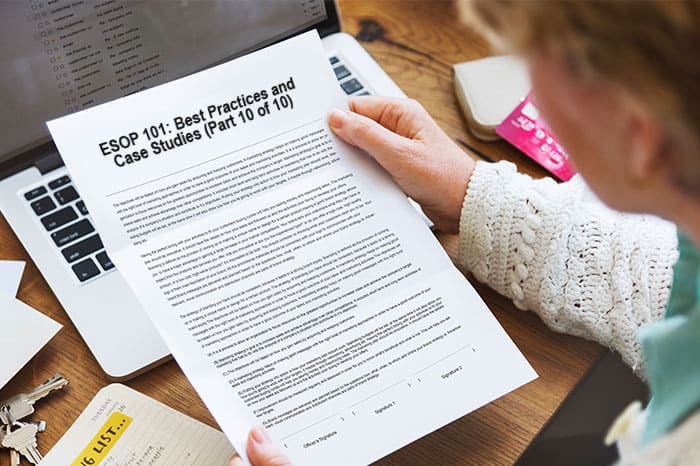
An Employee Stock Option Plan or ESOP is a benefit plan that provides employees of a company the ownership interest in the form of stocks or shares. The sponsoring company, the shareholders, and the employees receive various benefits in tax. This makes ESOP a qualified and attractive plan for many businesses.
Employers often use ESOP as a strategy for corporate finance to align the interests of the employee with that of the shareholders and the company. In other words, ESOP is a method employed by businesses to incentivize, sustain and reward competent employees. Through this share plan, eligible employees can purchase a certain number of shares in the company at an exercise price. Therefore, employees benefit when the share prices for the respective company increase.
Having a share option is not the same as having a share in a company. The exercise of the share option provides you with the right to acquire shares in a company. Upon fulfillment of certain conditions, share options are vested in the employee. The option holder can exercise their right and acquire stocks in the company. In order to have a successful ESOP structure, there are certain practices that a company is required to follow.
Best ESOP practices
If you are planning on setting an ESOP structure in your company, you should be aware of ESOP practices that help generate maximum benefit from the scheme:
1. Connect with a proper financial advisor
In order to receive comprehensive help to establish an ESOP, it is crucial to seek recommendations from an expert. They will be able to offer guidance on the legal, fiduciary, fiscal, and administrative aspects of the process. Ensure that the advisor’s experiences, legal fees, and success rate are in establishing growth-oriented ESOPs discussed before engaging with them.
2. Establish the workings of your ESOP
To achieve the most satisfactory plan, the company must determine its requirements and organizational structure. You must determine the type of plan, the amount of stock to purchase, the number of employees who will be covered by the plan, and the vesting timeline. The company must seek to create a clear ESOP plan that everyone can comprehend and rely upon. This ensures that the company and its employees reap the maximum benefits of the plan.
3. Accommodate changes in ownership
When you create an ESOP, the ownership of your company is bound to shift. Unless no employee exercises their vested rights, the company will have to accommodate new shareholders in the company. Every shareholder must therefore understand how the ownership structure of the company will change through the ESOP. They will also benefit from understanding its impact on the company and their ownership. It’s crucial to remember that vesting is a lengthy process. The ownership status does not change overnight through ESOPs. Consider allocating the options over three to four years of the vesting period. Reserving ten to fifteen per cent of the overall ownership into an ESOP pool is appropriate.
4. Get a 409a valuation
An independent third party’s evaluation of the fair market valuer or the FMV of the equity shares of a private corporation is known as a 409a valuation. Usually, the company covers the cost of these evaluations. These evaluations determine the price at which employees can purchase shares of the company’s common stock. The percentage of a company’s capital set aside for its founders and workers is known as common stock.
To ascertain the fair market value of the plan, the company must obtain a 409a valuation of its stock options. This will guarantee that your ESOP is valid legally and fairly and represents the worth of the company. If you’re working with a professional advisor, they’ll probably have a suggested approach and might even be able to perform the appraisal.
5. Acquire approval from the board of directors
In order to receive legal recognition of the ESOP, the consent of the board of directors is necessary. In addition to that, Everyone who has a confirmed financial interest in your company- like the shareholders- has to be consulted. This is relevant even if the board of directors for your company is not yet formally elected. In addition to avoiding potential legal violations, the board’s advice and experience can ensure that your ESOP is set up to best suit your company.
6. Prepare the required documents for the finalization of ESOP
The company must plan and gather the essential papers before finalizing its ESOP. The required documents entail agreements with all option holders, ESOP plan agreements and option grant agreements. You can adjust the company articles in your business plan to include your ESOP if required.
A Case Study on ESOP of WestLand Resources
The company WestLand Resources observed absolute employee ownership in the year 2021. The Tucson-based company includes a diverse group of employees ranging from scientists to business experts. In order to reach that stage the company took assistance from the Menke group to advise their ESOP structure. The employee Stock Option transaction was funded by a lateral transfer. This is a rarely used mechanism that permits employees to fund their stock purchase using funds in their 401(k) accounts. The mechanism was greatly advantageous for initial funding and providing security for the future of the company’s employees.
Conclusion
If your company wants to obtain the maximum benefit from your stock option plan, it is crucial to have a proper financial advisor for the ESOP committee. You need to establish proper rules and regulations outlining the qualifications and responsibilities of employees entitled to the stock option. Since the ESOP will increase the company’s shareholders and dilute the shares of existing shareholders, the company needs to be ready to accommodate the new shareholders. Before receiving the board’s approval, it is recommended to obtain a 409a valuation of the company shares. For the maximum growth use the above mentioned best ESOP practices and case study.
You may also like:
- ESOP 101: Introduction to Employee Share Option Plans (Part 1 of 10)
- ESOP 101: Understanding Vesting, Exercise, and Expiration Terms Part-2
- ESOP 101: The Process to Set Up an Employee Share Option Scheme Part 3
- ESOP 101: Communicating and Administering an ESOP – Part 4
- ESOP 101: Tax Implications and Accounting of an ESOP Part 5
- ESOP Benefits for Employees, Business, and Shareholders (Part 6 of 10)
- ESOP 101: Option Scheme Drawback and Maximizing Value Part 7
- ESOP 101: Risk and Compliance with Stock Option Scheme Part 8
- ESOP 101: Role in Stock Option Pool and Equity Financing Part 9





